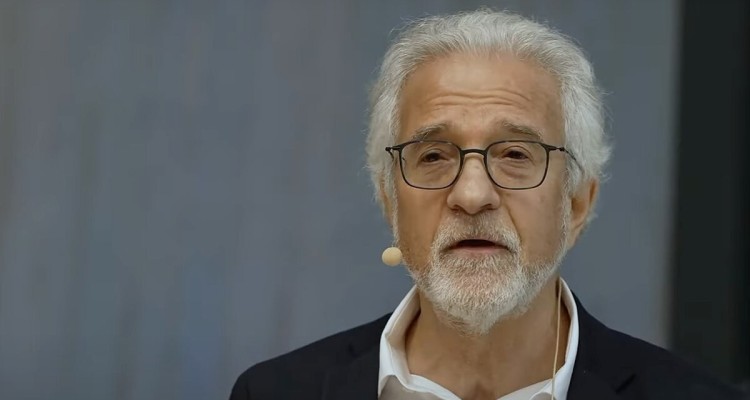The concept of “metaphysical antisemitism” was first used by Bernard Lazare – notably to explain the sophisticated antisemitism of intellectuals and philosophers – before being used by Gershom Scholem and Hans Jonas to identify Heidegger’s antisemitism. It implies the conception of an alienated reality, within which the Jew and the Jewish worldview are fundamentally at fault. What about the critique of an alienated reality that regularly deviates into a guilt-tripping of the Jews?

“However, they are still different, and often in an indefinable way.” – Sigmund Freud, Moses and Monotheism
“I have been made the fable of the nations, says Job.” – Bernard Lazare, “The Manure of Job”
Antisemitism not only contains primitive elements that resist deconstruction, but it is able to draw on its critics to be reborn in a new form – as is the case, for example, with the use of the memory of the Holocaust that is turned against the Jews themselves. The polymorphism of this particular hatred, capable of summoning up contradictory motives of detestation toward the same subject – it is possible to hate the figure of the Jew as victim, or the Jew as conqueror, the Jew as instigator of socialism, or of capitalism, and sometimes all of these figures at the same time – this polymorphism, therefore, is the sign of an original indeterminacy in which the plurality of these fantasies and projections is lodged. The difficulty lies therefore in the circumscription of an absence of definition, whose effects we can capture and whose causes we can infer. So antisemitism is fully a philosophical problem, from Marx to Badiou, stopping by Sartre along the way. The reflection on the universal and the particular since political modernity has been expressed via debates over the Jewish question, pivoting then also around the attempt to define the Jew, according to what he should be or cease to be.
But we could immediately reproach this approach with theoretical excess, an intellectual sophistication, incapable of encompassing a more visceral dimension of a hatred that has been persecutory, then exterminatory, and that intermittently, but often enough, still expresses itself in the murder of Jews in France. This phenomenon, present since the dawn of the new century and termed “the new antisemitism,” is linked in particular to the importation of the Israeli-Palestinian conflict, and to the emergence of Islamist terrorism. Once again, hatred is on the move. Certainly, books and diagnoses on antisemitism and Judeophobia abound. What remains is the enigma of the longevity of this hatred, which was not exhausted in the camps, and which haunts even the places from which the Jews disappeared. The theory of the scapegoat in particular, even if it grasps interesting mechanisms of social expiation and purification, nevertheless assumes that the sacrificial practice tends to resolve a social imbalance. However, antisemitic acts appear rather as heralds of a greater social imbalance to come.
Symptomatic of an ongoing or future crisis, the manifestation of antisemitism expresses the will to attribute a guilt embodied in the Jew, or the Jewish people, likely to justify the presence of evils as different as the plague, an economic crisis, the feeling of moral decadence. The contingency of these evils opens up a cognitive gap into which a “diabolical causality” insinuates itself, according to the expression of the historian of antisemitism Léon Poliakov. This causality, and even the satisfaction that accompanies the actualization of this hatred, is, in the words of Adorno and Horkheimer, “the shadow of knowledge.” It points to an element of ancient regression in the ontological correlation of Jew-guilt, but also of Jew-devil, which finds ways of re-emerging at certain crossroads or periods of history, during the Inquisition, the Dreyfus Affair, the Second World War, the resurgence of conspiracism. The theology of a deicidal people, or the Freudian psychoanalytical guilt of a people that has killed the father and takes responsibility for it by setting it up as an invisible sovereignty, are elements that are perhaps sufficiently known. The Jew-devil correlation, on the other hand, seems to contain a reversal mechanism (from a chosen people of God to a people subjected to the devil), which Hans Jonas assimilates more simply to a process of devaluation of Judaism and the Jews. It is still necessary to understand the function of this devaluation. This implies going deeper into the notion of metaphysical antisemitism, which goes back to late antiquity and is little studied – Bernard Lazare, however, devotes a chapter to it, which is actually dedicated to intellectual antisemitism.
The expression used by Gershom Scholem and Hans Jonas to circumscribe the kind of antisemitism of ancient gnosticism, metaphysical antisemitism, thus belongs to a so-called heretical current, distinguished from institutionalized Christianity (and repudiated by it). It responds to a singular representation of the world dominated by a deep and radical feeling of alienation from the world. The feeling of belonging to a foreign and hostile world establishes a form of cosmic oppression. The mythological perspective however attributes an intentionality to this oppression and accuses in particular a divine, malevolent force. The world being evil, the origin of the evil must be attributed to the creator of the world, Ialdabaôt, the God of the Jews, who then becomes, in this mythology, the demiurge. This initial reversal is particularly instructive, insofar as it produces an inaugural and occult guilt, because Gnostic knowledge is initiatory. It could be a question of a reversal of values limited to competitive positions between religions and mythologies which battle for a dogmatic hegemony at the beginning of the Christian era – an era marked in particular by a geopolitical instability of reconfiguration of the empires. But it denotes a kind of “confabulation” which consonates with the mechanism of antisemitism or anti-Judaism, if we take up the phrase in the epigraph chosen by Bernard Lazarus to determine the origin of the suffering of the Jewish people.
In this confabulation, we find the projection of a will of domination and oppression of the order of the conspiracy. But let us understand that it follows an affect of feeling alienated and powerless with regard to a world perceived as strange. The origin of this feeling, itself at the origin of an unhappy conception of the world, is unknown. It may very well be proportional to the will to extricate oneself from one’s condition, to seek a redemption as transcendent as our condition is base. But to this, which could be only a principle of animating knowledge, is added the idea of a Jewish God who has counterfeited this world. Counterfeiting, lying, manipulation, then become rhetorical attributes of anti-Judaism. The function of locating the lie also makes it possible to establish its truth. The antisemitic literature that associates Jews and lies is significant here. The justification of this “discursive” practice is, in the Gnostic framework, mythological: it claims to answer the question of the origin of evil. That ancient gnosis remains attached to a historical context does not mean, however, that gnostic motives cannot reappear, and notably when the notion of alienation of the human condition is emphasized. It is by this means that Jonas spots an antisemitism of a metaphysical type in the Heideggerian theory of being. The latter, like gnosis, supposes that the being is thrown away, abandoned, dominated by an anguish affect generated by its presence in the world. Does the feeling of alienation from the world dispose one to antisemitism? In other words, does the observation of an essentially hostile, perverted or corrupted world engender this particular hatred, which feeds readily on complex theories? Or conversely, does the suspicion stimulated by antisemitism lead to a “gnostic” worldview? Without being systematic, this reciprocity exists. The link between antisemitism and alienation from the world is not limited to modernity; it goes back to antiquity, as we have already pointed out, and it has been going on throughout history. So that the criticism of political modernity as having generated universalism and rootlessness, or of modernity as having generated destructive technology, and in which antisemitism is lodged (the Jews having an interest in an emancipatory universalism, or “calculating,” “materialistic” Judaism at the origin of a mechanical rationality), contain ancient elements of the accusation against the Jews. Elements that may have been secularized, but more importantly, psychological elements, resulting from the feeling of alienation from the world, which also implies a feeling of dispossession. Hans Jonas showed in particular that the feeling of dispossession in the context of ancient gnosis followed the fall of empires and the atomization of political powers, a context which is therefore similar to the end of the 19th century in Europe.
Let us add to the psychological and political elements the economic elements. Everything that has to do with the feeling of dispossession is the object of a questioning on the origin of this possession. The problem lies in the phantasmagorical, demonological drift of this quest. A group is then designated as the agent of evil. The structure of antisemitism in materialist theories, such as those of Moishe Postone, is based on this mechanism. The feeling of economic alienation is increased tenfold by the abstraction of a squared-off speculation, and within this disembodied capitalism, there is the need to denounce an occult intention, traditionally projected onto the Jews. Postone emphasizes that one should be able to think of an a-subjective capitalism, or an a-subjective alienation, without subject, without personification of the accusation. The “left” populism is supported by this kind of drift. Does the critique of an economic alienation join the model of a metaphysical alienation? In any case, metaphysical antisemitism is based on a conception of the world, and the economy and its crises are setting the pace.
Are the Jews holders (possessors) of something invisible, like their God, in which there is both an attraction and a rejection? Theories on antisemitism oscillate: should we look at the Jew and Judaism to understand the reasons for hatred, or are the grounds for accusation so varied that we must look exclusively at the antisemite?
In his book Ecstasies: Deciphering the Witches’ Sabbath, Carlo Ginzburg links the persecution of Jews to that of witches in the Middle Ages. The mechanism is the same: the fear of those who, on the margins of society, are supposedly possessed by the devil or have made a pact with him, and thus must be hunted down and chased away. Marginality is a position on the border of two worlds, of the visible and the invisible, of life and death. The fundamental fear projected on the Jews, the witches, the lepers, has to do with their traffic with the invisible world, that is to say the world of the dead, from which they draw an occult power on the world of the living. This total, panic-based fear takes on metaphysical proportions, hence the collective or mass participation in persecutions. The historian anchors hostility toward the Jews in the relationship that groups have with the invisible, which engages a reflection on the boundaries between reality and fiction, rationality and irrationality.
Is this again a sign of the reversal characteristic of metaphysical antisemitism, if, as Max Weber assumed, the Jews are reproached for a disenchantment of the world, that is to say, a rationalization of ethics or the abandonment of magic, so that, by way of compensation, infinite fictions and spells are projected onto them? Apart from the kind of fable that led to contempt, as Lazare indicated in The Manure of Job, there remains an indefinable element of Jewish difference, as Freud put it in his Moses and Monotheism. Now, this element of undefinable difference for all, and for the Jews themselves, contains an element of distance within its own identity. This differential distance places the Jews at the risky crossroads of appropriations of their intentions, regularly on trial inquisitively throughout history. It is as if this distance called for a desire for a violent hold, for the appropriation of the figure of the Jew and of his history. The distorting morphology of antisemitism forces us to return to this dialectic of possession/depossession – another way of identifying the power relations that are expressed in the spheres of existence, whether social, economic or political.
Are not the figure of the Jew and the Jewish signifier,in fact the places where power struggles and social conflicts are crystallized? But what would be the function of this appropriation? There is an element of avoidance in antisemitism, which is well-known, and which acts as a rejection of one’s faults, of one’s guilt. But the mechanism must be clarified in the light of current events. Let us see in the latest manifestations of antisemitism in France, in particular in the demonstrations decrying economic discontent, a revolt against a power felt to be too normative, how antisemitism has arisen. It is always a surprising emergence: how and why, at the crossroads of conflicts that are fine without the Jews, are the Jews summoned under the banner of the mysterious “Who?” (Translator’s Note: Some anti-health pass protests in France featured antisemitic demonstrators who used an antisemitic meme to blame a Jewish conspiracy for public health policies.) Why are those who are usually excluded, perceived as a foreign element in society, simultaneously reincluded in the role of invisible manipulators? The secrecy attached to the Jews makes them vulnerable to hostility, not political but social, insofar as the framework of the nation-state presupposes a political rationality that is separate from the people, and therefore distrusted by the people – and which necessarily escapes them. In other words, everything that comes under the heading of state secrecy, of raison d’etat, the whole subterranean dimension of power but legitimized by a tradition of political philosophy, is also the blind spot where the feeling of dispossession of power is lodged in times of crisis. The supposed exteriority of the Jew then allows them to be associated with the power that is nevertheless the power chosen by a people to which they belong. And this displacement allows one not to accuse oneself, to preserve oneself and to remain in a blissful political irresponsibility. Was not the famous young woman with the sign whose image was relayed in the media all smiles, happy to have exhumed the list of those responsible for the French misfortune? The place of the Jew is at the border of the political and the social, like the fiction of a buffer zone between the power and the people, monopolized according to the circumstances by one or the other, testifying to the insufficiencies of the first and the dissatisfactions and resentments of the other. Then violence against those who have been trapped in this space can unfold.
Avishag Zafrani









